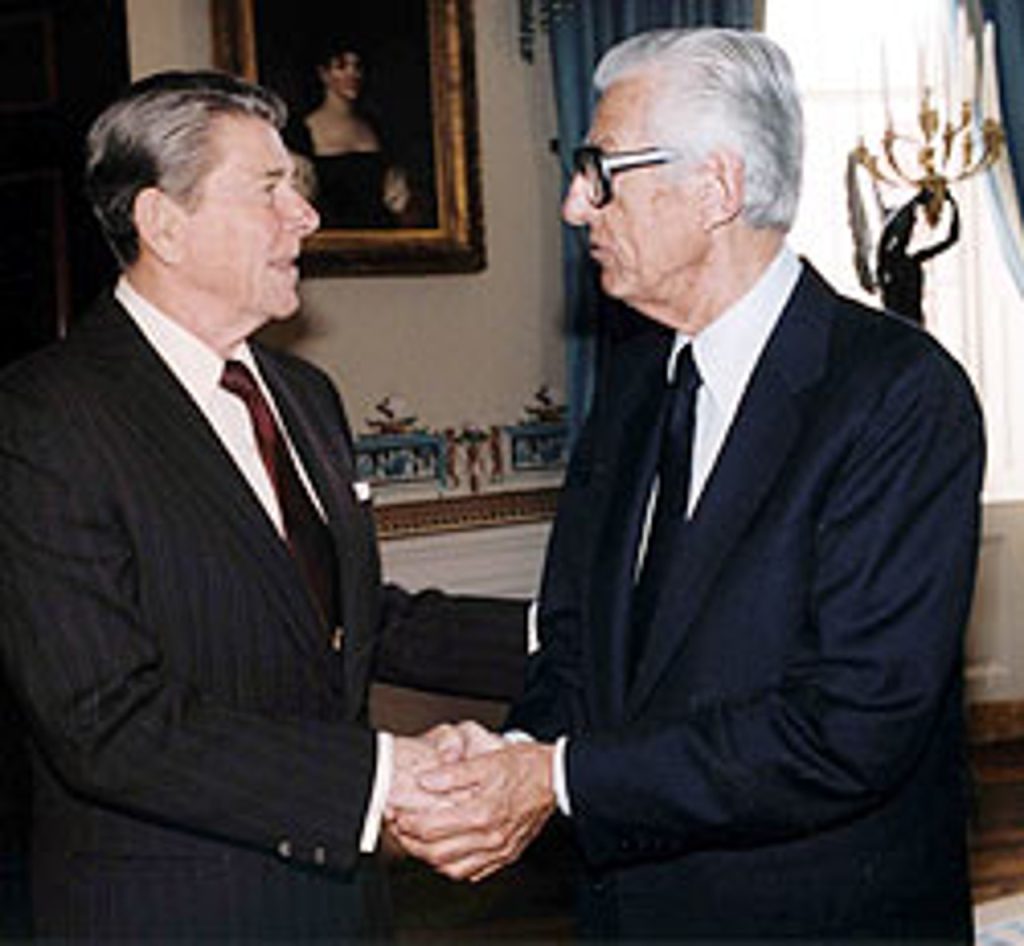
The Octopus Murders docuseries about the suspicious death of journalist Danny Casolaro in August 1991 has caused quite the sensation since it was released February 28 on Netflix.
Casolaro’s goal to uncover “the Octopus”—a cabal of CIA and Mafia figures who corrupted American government—was so all-consuming that it enveloped his physical life and his legacy as a writer. Yet, there are significant omissions in the public’s understanding of “the Octopus.”
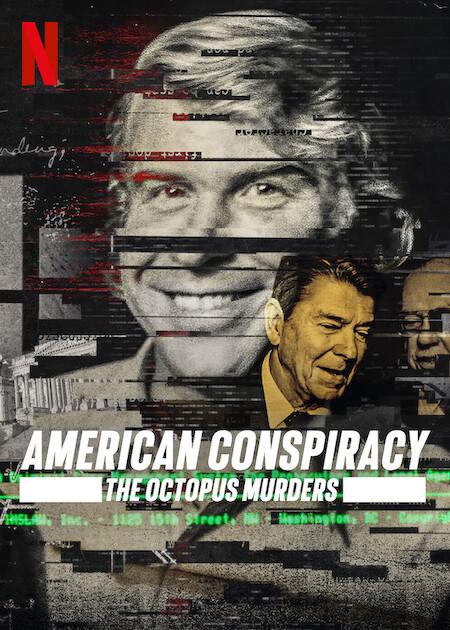
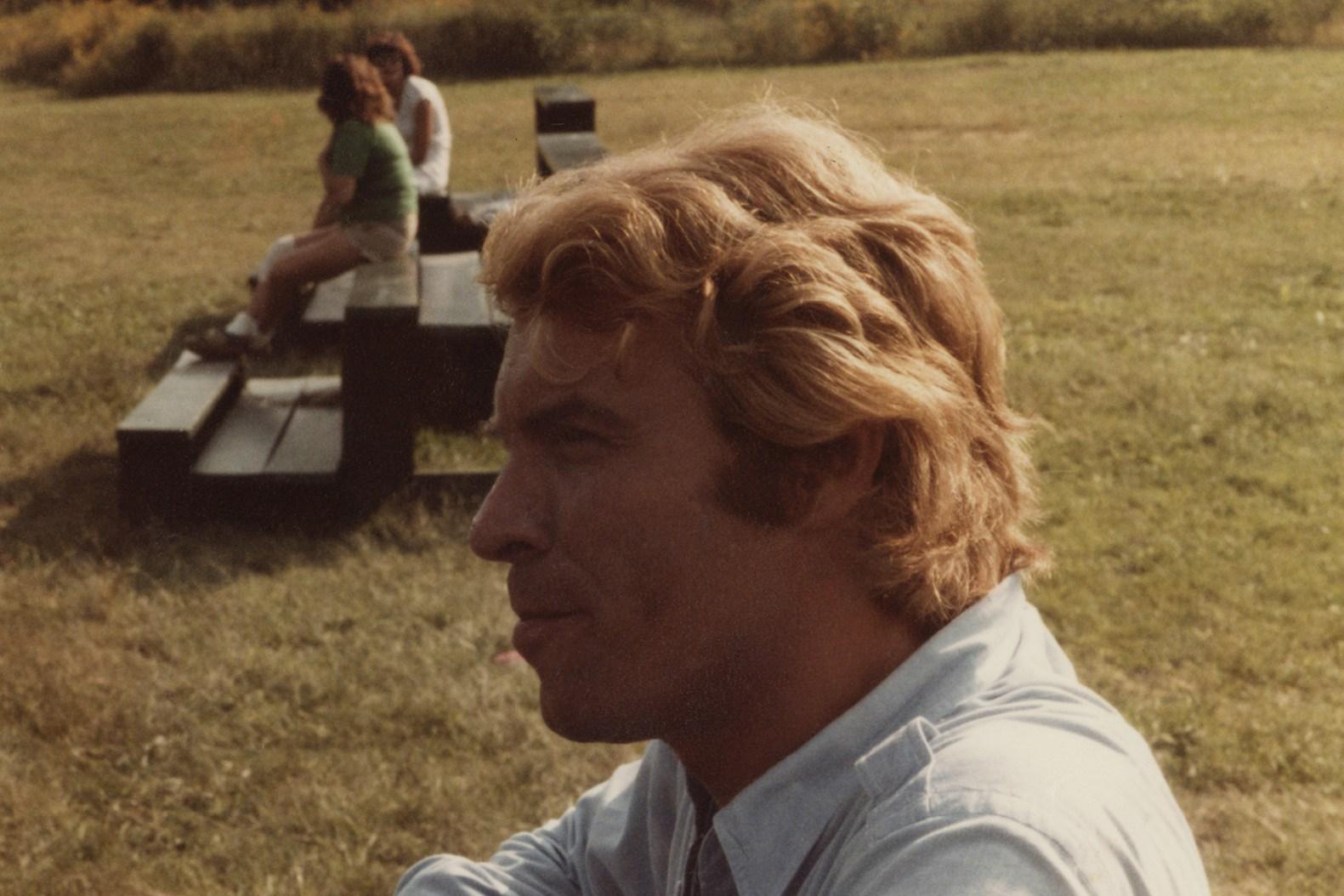
This includes a spotlight on the intersection of conglomerates Music Corporation of America (MCA) Inc. and Litton Industries, as well as how “the Octopus” intersected with the work of Danny’s father. Shortly before Danny died, he reportedly told FBI agent Thomas Gates he had damning information about MCA’s involvement with other tentacles of The Octopus.
There was a decades-long intimacy between people in the Reagan administration, MCA and Litton Industries. Even more curious is that Litton would ultimately buy Bionetics Research Laboratories, a company founded by Dr. Joseph Casolaro. This article aims to help those familiar with Danny’s case understand that Danny may have been much closer to breaking the case than previously acknowledged.
MCA’s Monopoly in Hollywood
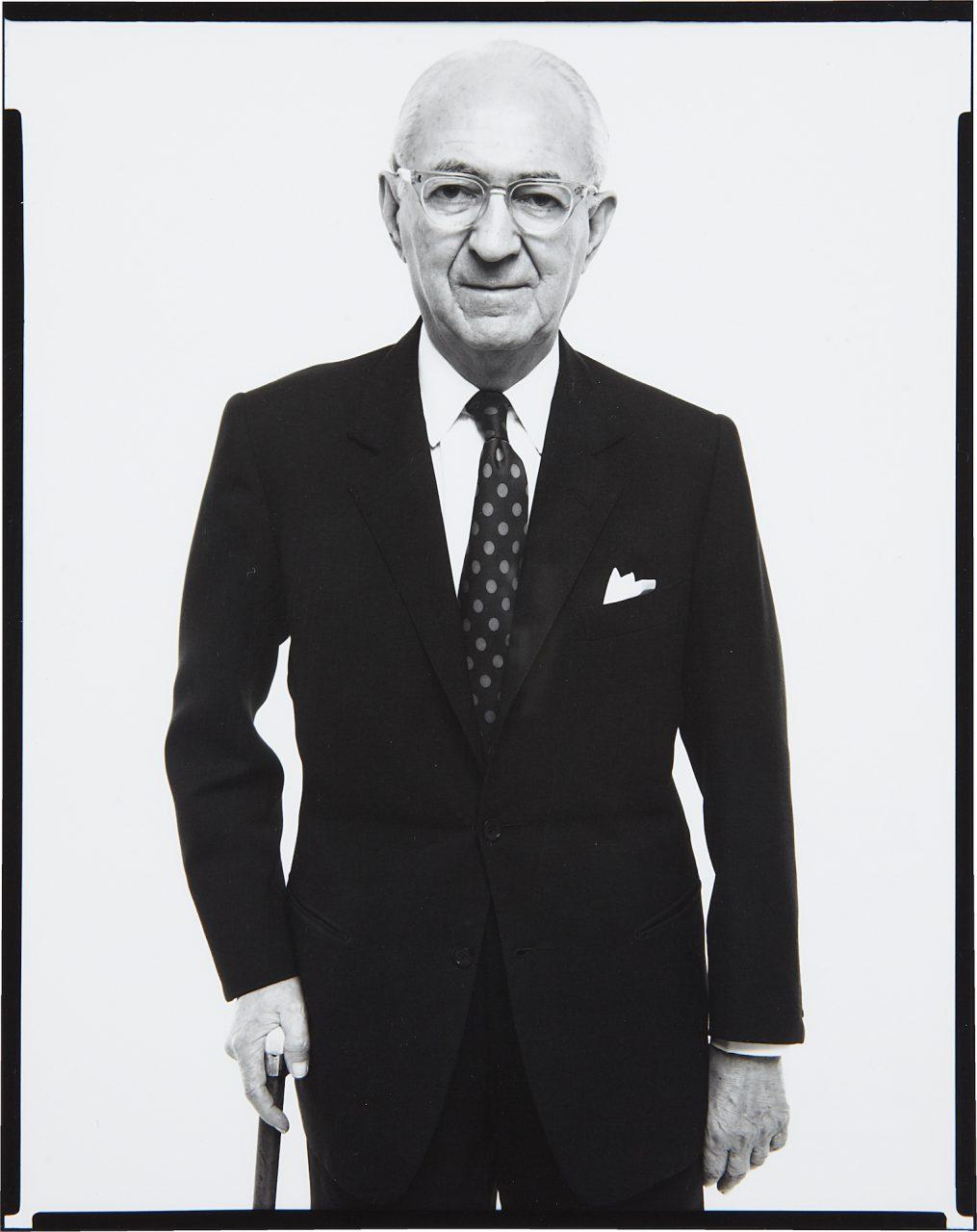
Music Corporation of America (MCA) was founded by Jules Stein in 1924. MCA began as a talent booking agency in Chicago nightclubs during Prohibition. From the beginning, MCA had ties to Al Capone and organized crime figures in Chicago stayed intact for decades to come,[1] relocating its headquarters to Hollywood where it would expand and diversify.
It was always known for its aggressive business tactics and faced multiple investigations during its reign. MCA began to receive national attention in 1946 during a federal antitrust case.

“In deciding against MCA, the judge called the talent agency ‘the Octopus … with tentacles reaching out to all phases and grasping everything in show business.’”
– Dan E. Moldea, Dark Victory: Ronald Reagan, MCA, and the Mob
Ronald Reagan and Lew Wasserman
Lew Wasserman, who had been Ronald Reagan’s talent agent, took over MCA in 1946. The ascendancy of Ronald Reagan’s political career coincides with MCA’s dominance in the entertainment industry. Wasserman would facilitate Reagan’s rise to President of the Screen Actors Guild (SAG) (1947-1952 and 1959-1960), Governor of California and ultimately President of the United States. Furthermore, as an actor, Reagan was also an informant to the FBI on alleged communist sympathizers during the Red Scare.
As President of SAG, Reagan gave MCA a waiver in 1952 so it could represent talent and become television producers, which created a significant conflict of interest. Conversely, SAG’s highest priority in contract negotiations was for producers to pay residuals to talent when their work was rebroadcast on television. Because MCA agreed to pay residuals, this became standard practice for all of the production studios.
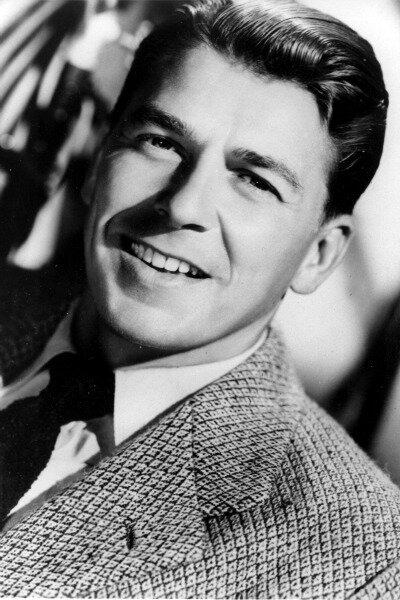
Antitrust Enforcement in Hollywood
The swift collapse of the Hollywood studio system was hastened by the Supreme Court’s 1948 ruling in favor of the Department of Justice (DOJ)’s antitrust case against the studios. This resulted in the Paramount Decrees, which were a boon for actors’ earning power, stature and creative freedom. Yet, this industry restructuring was even more beneficial to talent agents who were now able to have the upper hand by bundling superstars into package deals.
MCA’s 1962 Antitrust Case
MCA came under another DOJ antitrust investigation when Robert F. Kennedy became Attorney General in 1961. MCA[2] had been pursuing the acquisition of Universal Pictures, which would have been a violation of the Sherman Antitrust Act and destroyed the distinction between labor and management. At that time MCA had “700 actors and actresses under contract, 300 Broadway actors, all the ‘Big Bands’ and major nightclubs in the largest cities.”[3] There were also widespread concerns in Hollywood that MCA was abusing its monopoly power.
On July 13, 1962, the federal government filed a civil antitrust case against MCA, with SAG named as a co-conspirator. In less than two weeks MCA agreed to dissolve its talent agency business, which was only a small fraction of its business.
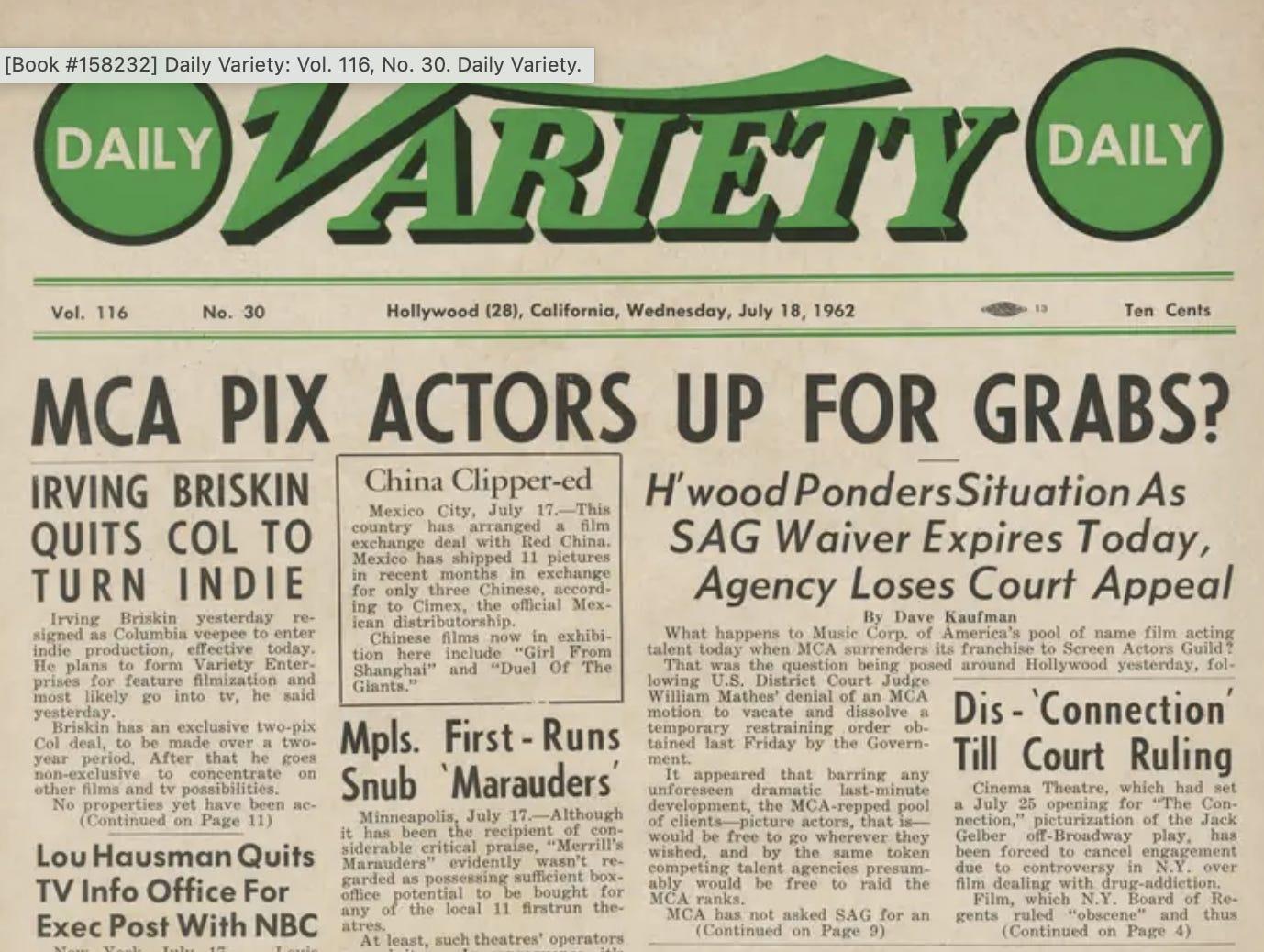
“The government had evidence that MCA had engaged in numerous civil and criminal violations of law and empaneled a federal grand jury to hear the specifics of its charges, which included restraint of trade, conspiracy with SAG to monopolize talent and film program productions, extortion, discrimination, blacklisting, and the use of predatory business practices. Among those called to testify was Ronald Reagan, who displayed a remarkable loss of memory while on the witness stand. Soon after, the federal income tax records of Reagan and his wife were subpoenaed for the years following the MCA-SAG blanket waiver.”
– Dan Moldea, Dark Victory: Ronald Reagan, MCA and the Mob
The final judgment in the case of United States v. MCA Inc. was entered on October 18, 1962. Everything had been resolved behind closed doors without any admission of guilt or significant consequences. MCA did have restraints placed upon its future mergers and acquisitions; although there was no issue with its recent acquisition of Decca Records and Universal Pictures. Decca Records would become MCA Records.
A Back-Door Deal?
In the wake of the 1962 antitrust case Wasserman realized he needed to build stronger connections in D.C. He focused on cultivating a strong relationship with Lyndon B. Johnson and becoming a more ardent political fundraiser.[4]
Wasserman even handpicked LBJ’s close confidante Jack Valenti to come to Hollywood in 1966 and become the President of the Motion Picture Association of America—the chief lobbying group for the film industry.[5]
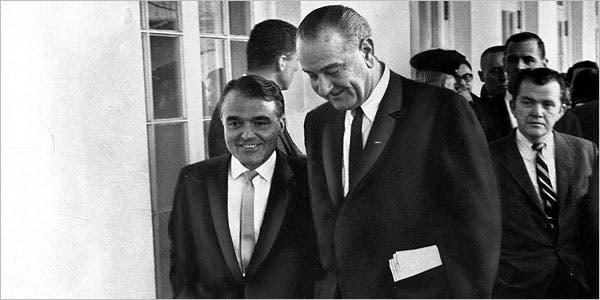
The entrance of LBJ into the White House ushered in a new era of closeness between Hollywood and D.C. Yet, how close had their enforcement arms become? History bares out the increasing permeability between the activity of organized crime and the military-industrial complex.
“The Central Intelligence Agency responded to the author’s three-year old Freedom of Information Act request in June 1998, acknowledging that seventeen separate computer searches revealed MCA did work with the CIA. The CIA refused to release any of its MCA documents on grounds that it might endanger national security.” – The Last Mogul, Dennis McDougal (pp. 339-40).
MCA may have been acting in some capacity as an international front for the intelligence services. But how deep was the collaboration? In 1972 Wasserman announced MCA’s development of the first proto-DVD player called DiscoVision, which garnered interest from the CIA so it could easily transport and retrieve classified materials. While the product never came to market, Wasserman did create a joint venture with Pioneer Electronics called Universal Pioneer Corporation, who did have the CIA as a client.[6]
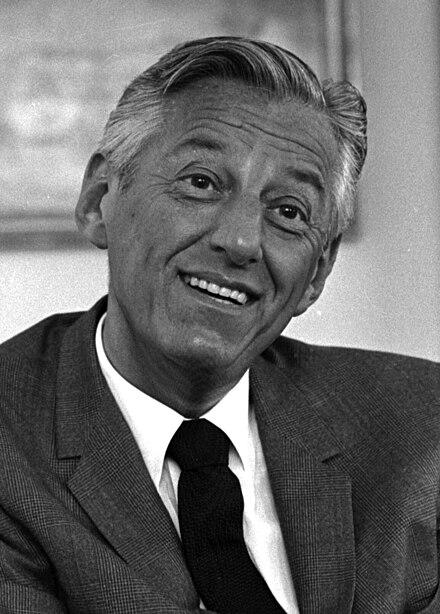
Intro to Litton Industries
For decades California has been at the juncture of defense spending and private industry. Through the leadership of Charles “Tex” Thornton, Litton Industries profited immensely from this arrangement and its attendant technological breakthroughs.
“Thornton ignored the old-line industrial pattern and concentrated on developing such new technologies as data processing, aircraft guidance systems, digital computers, and scores of other advanced electronic devices. Today Litton stands as one of the giants of American industry, employing over 76,000 workers, with 1979 sales of over $4 billion.
- California, Inc., Joel Kotkin
Tex Thornton first met Lyndon B. Johnson when he first became involved in politics back in their home state of Texas. Prior to launching his own business Thornton worked for Henry Ford II and Howard Hughes. As Litton’s business boomed, he maintained a strong relationship with LBJ and received a number of appointments, including to the Kerner Commission.[7] Executives at Litton knew how important it was to have a direct pipeline to D.C. and were some of Reagan’s biggest financial backers.[8] Tex Thornton and his wife were even able to celebrate with Reagan in-person when he won the presidential election on November 4, 1980.[9] Also in attendance was future Attorney General Edwin Meese III.
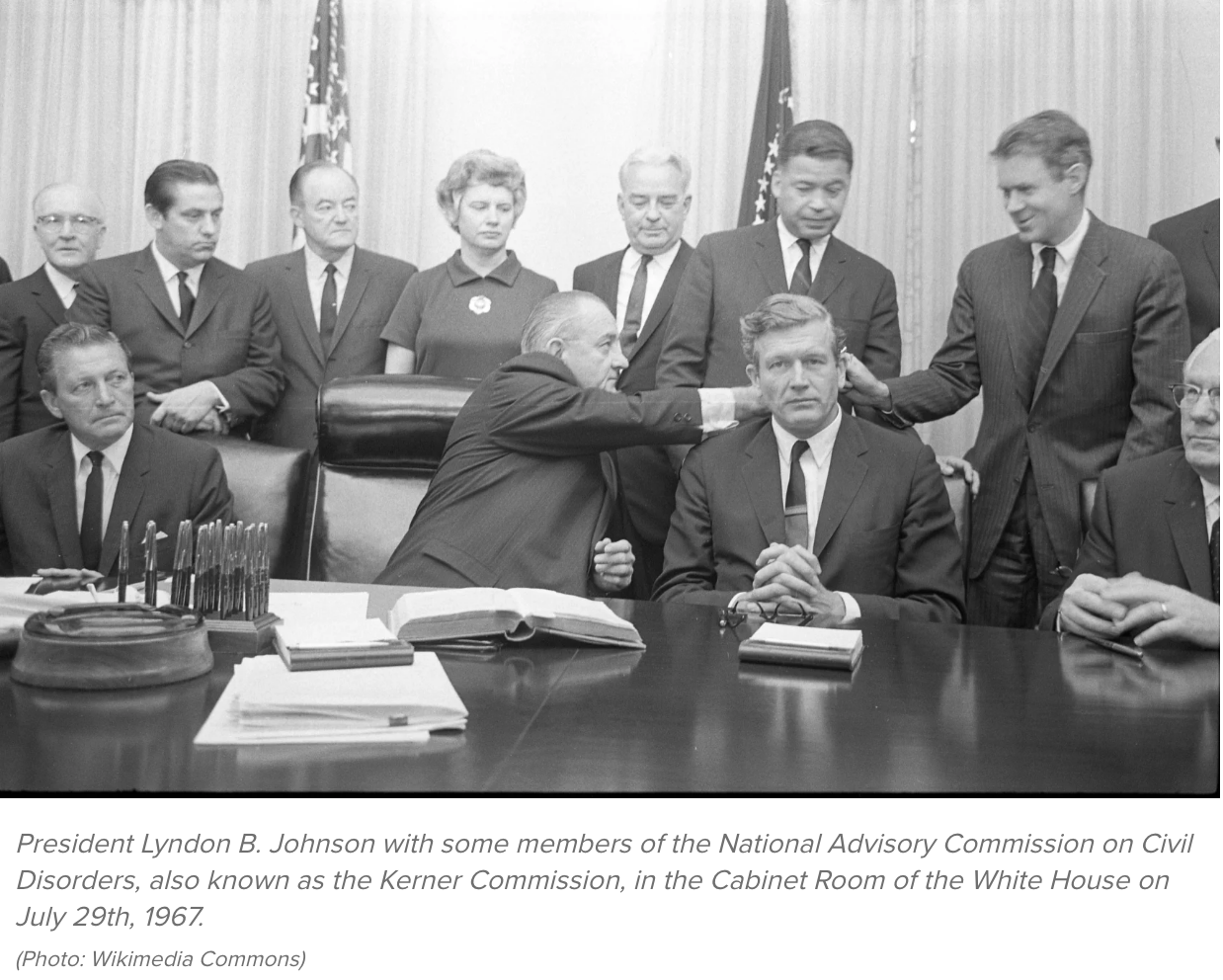
MCA and Litton
Once MCA dissolved its talent agency it moved its headquarters to Universal City. Jules Stein immediately entered into negotiations to sell its opulent Beverly Hills headquarters to Litton. The negotiations stretched over two years but, ultimately, Stein sold MCA’s headquarters in exchange for 28,000 shares of Litton stock.[10] The MCA/Litton Headquarters Complex is now on Beverly Hills Register of Historic Properties.
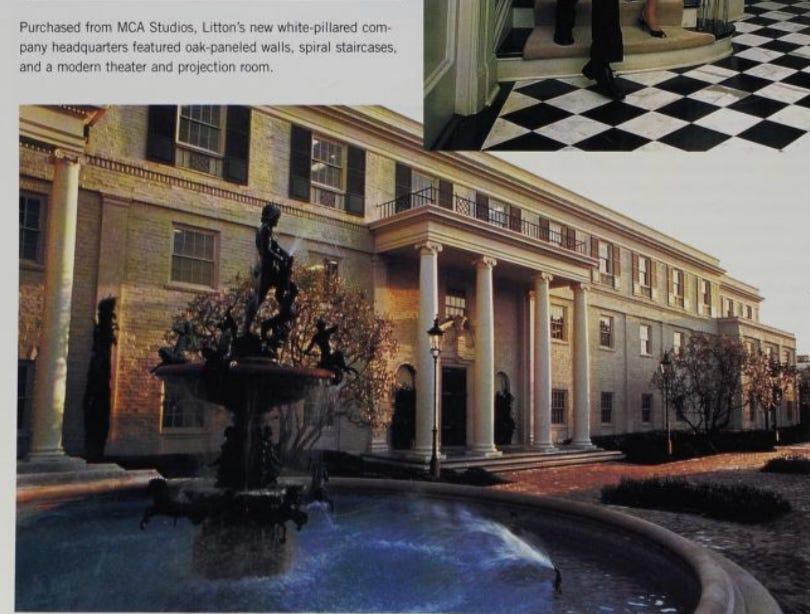
MCA and Litton maintained a cozy relationship and Thornton would serve on the Board of Directors of MCA. Thornton and Wasserman would both serve on the Board of Directors of the Los Angeles World Affairs Council, along with other luminaries, including the presidents of the Union Oil Company of California, Northrop Corporation, Aerospace Corporation, and the chairman of Lockheed Aircraft Corporation.
Litton’s Connection to Danny’s Octopus
The Litton Connection to the Cabazon-Wackenhut Joint Venture
A focal point of Danny Casolaro’s investigation was the Cabazon-Wackenhut Joint Venture (C-WJV). Wackenhut Corporation sought to use the sovereignty of the Cabazon Indian reservation to manufacture and sell military products to foreign governments, such as the Nicaraguan Contras. The aim was to bypass U.S. regulations and limitations on foreign exports of military products. According to Wackenhut’s internal correspondence the C-WJV was pursuing the opportunity to assemble and sell Litton’s night-vision goggles on the reservation.
Wackenhut Vice President Robert Frye told FBI investigators that Robert Booth Nichols made the initial introduction between C-WJV and Intersect Corporation President John Vanderwerker. The deal had to go through Intersect Corporation which had “the apparent exclusive rights for foreign marketing with the Litton Electron Tube Division in Third World countries.” There were also discussions of selling Litton’s night-vision goggles to Guatemala and Jordan.[11]

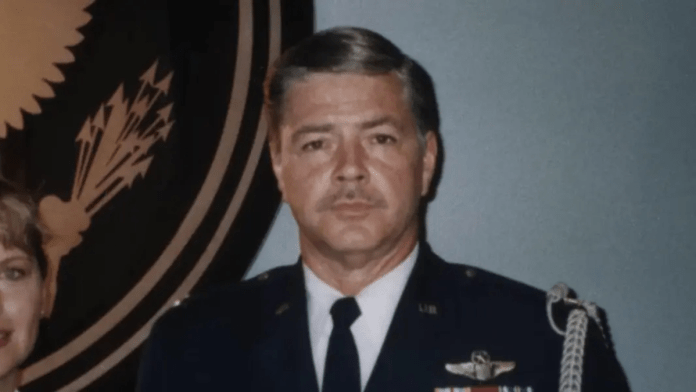
Litton and BCCI
The Bank of Credit and Commerce International (BCCI) was tied to many facets of Danny Casolaro’s Octopus, including the Iran-Contra scandal and the October Surprise. A series of international investigations found BCCI was laundering massive amounts of money and committing an assortment of other crimes. In December 1992 Senators John Kerry and Senator Hank Brown issued a report to the Committee on Foreign Relations entitled The BCCI Affair.[12] This report reviewed BCCI documents and found it was acting as a go-between for the Argentine government’s attempt to buy night-vision goggles produced by Litton.
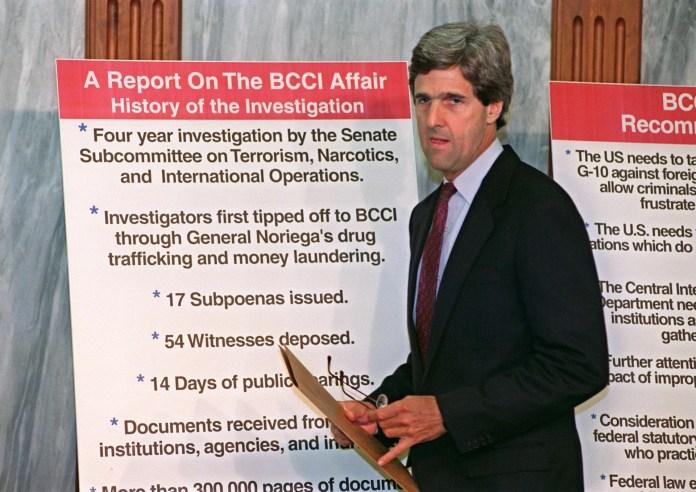
In the above example two entities of Danny’s Octopus, the Cabazon-Wackenhut Joint Venture and BCCI, are involved in the attempted purchase of Litton night-vision goggles. It is odd that Litton, one of the U.S.’s biggest defense contractors, is not a more notable component in the conversations around The Octopus. Litton was also subject to a federal investigation in the 1980s, just like the PROMIS scandal, BCCI and MCA. Or were these all just tentacles of a centralized crime syndicate?
MCA, Organized Crime and the Justice Department
Danny Casolaro was in frequent communication with federal investigators who were looking into MCA’s close ties to the Mafia. This included FBI Special Agent Thomas Gates and Special Prosecutor Richard Stavin of the DOJ’s Organized Crime Strike Force. Furthermore, Danny was also regularly in touch with Robert Booth Nichols who was in business with the President of the MCA Home Entertainment Division, Eugene Giaquinto. MCA was a large, yet forgotten, piece of Danny’s investigation.
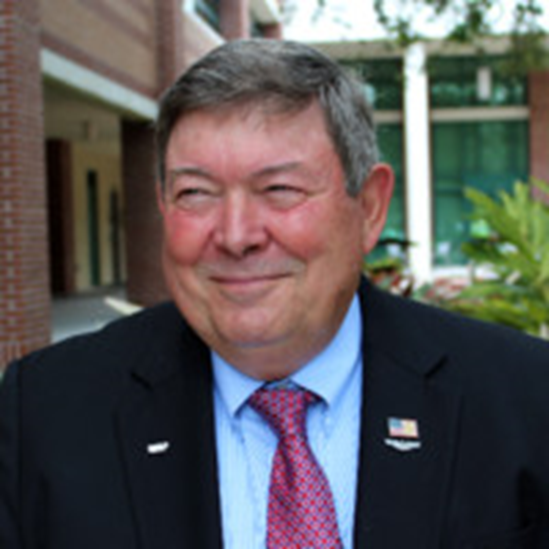

A source provided Cheri Seymour with documents that were under seal and originated from the House Judiciary Committee’s investigation into the INSLAW case. One report included in these documents satiated the following statement: [NOTE: “satiated”? I don’t understand.]
“The confidential source said Danny Casolaro called Thomas Gates a few days before his death and asked Gates to come to Martinsburg, VA to meet with him. Casolaro said he had valuable information relating to MCA and illegal activities. Gates told Danny he could not justify the trip. Danny’s body was found in a Martinsburg hotel a few days later. Gates was very upset about this and initiated official authorization to testify to the Judiciary Committee about the death of Danny Casolaro.” – Report No. 9[13]
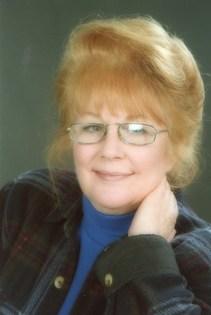
A Web of Federal Investigations
There were multiple overlapping federal investigations into the Mafia’s involvement in the entertainment industry, including the use of payola (pay to play songs on the radio), labor racketeering in the movie industry, and the manufacturing and sale of records and home videos. Describing this spiderweb is beyond the scope of this article, but there are some crucial facts that are salient to Danny Casolaro’s Octopus.
The federal investigators’ ultimate goal was to build a RICO case that would dismantle the Mafia’s involvement in the entertainment industry. Yet, federal prosecutors and the FBI hit a wall once it reached the executive suite at MCA, Inc. There was interference from the highest levels of the Department of Justice and, presumably, Reagan’s White House. 60 Minutes aired an episode “Hollywood and the Mob” in 1989 that provides a succinct introduction to these overlapping investigations.
U.S. Attorney Rudnick and Sal “The Swindler” Pisello
U.S. Attorney Martin Rudnick learned that Sal “the Swindler” Pisello, a “made man” in the Gambino crime family and reputed drug trafficker, was involved in brokering multimillion dollar deals for MCA Records. One of Pisello’s deals—selling MCA record cutouts (old stock)—went wrong and involved Genovese crime family associates Morris Levy and Tommy Vastola. John Lamonte was a bulk purchaser who was seriously injured for refusing to pay for a load of poor quality cutouts.
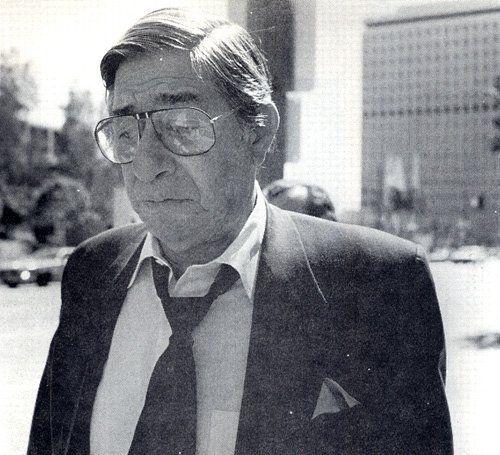
Rudnick wanted to understand why a huge corporation like MCA would work with a known mafioso like Pisello, who ended up getting convicted of tax evasion related to his dealings with MCA. MCA Records’ Irving Azoff was a prime target of Rudnick’s investigation involving a host of criminal activities, including his dealings with the Mafia and using payola for MCA artists. Despite strong evidence against Azoff, he was rewarded by MCA, including extending his contract and buying three of his companies for 500,000 shares of MCA. Azoff also diverted attention from his activities by directing attention for payola schemes run by independent record promoters called “The Network.”
NBC Nightly News aired a special report on February 24, 1986, regarding the use of payola in the music industry. Overnight, the report essentially ended The Network’s payola business.
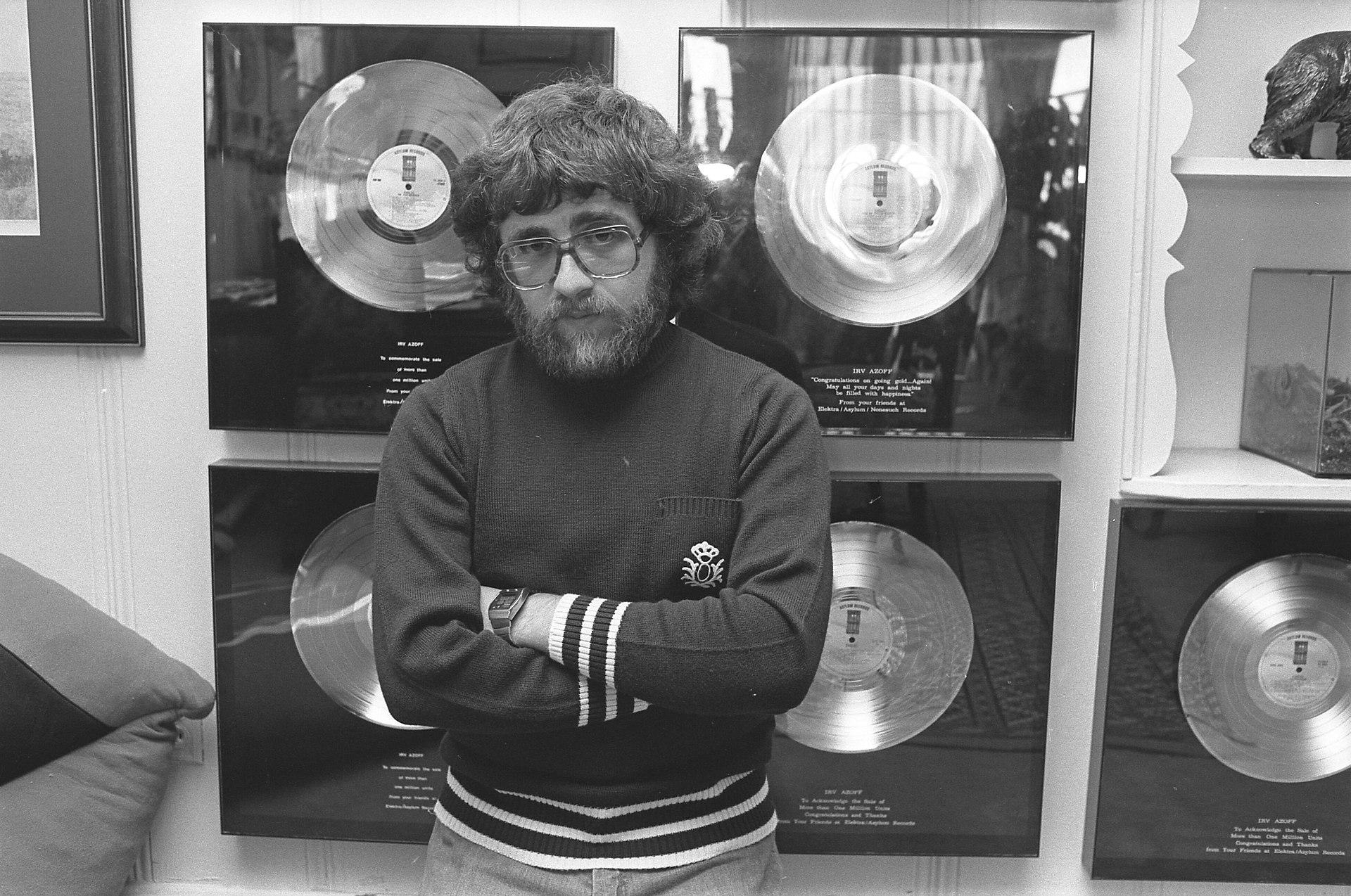
A few months later an independent promoter sued most of the big record companies for antitrust violations for colluding against independent promoters. Ironically, MCA was entering the artist management business again by buying Azoff’s Front Line Management.[14] MCA’s acquisition of an artist management company was cleared by the DOJ, while the DOJ also intervened to limit the scope of Rudnick’s investigation.[15]
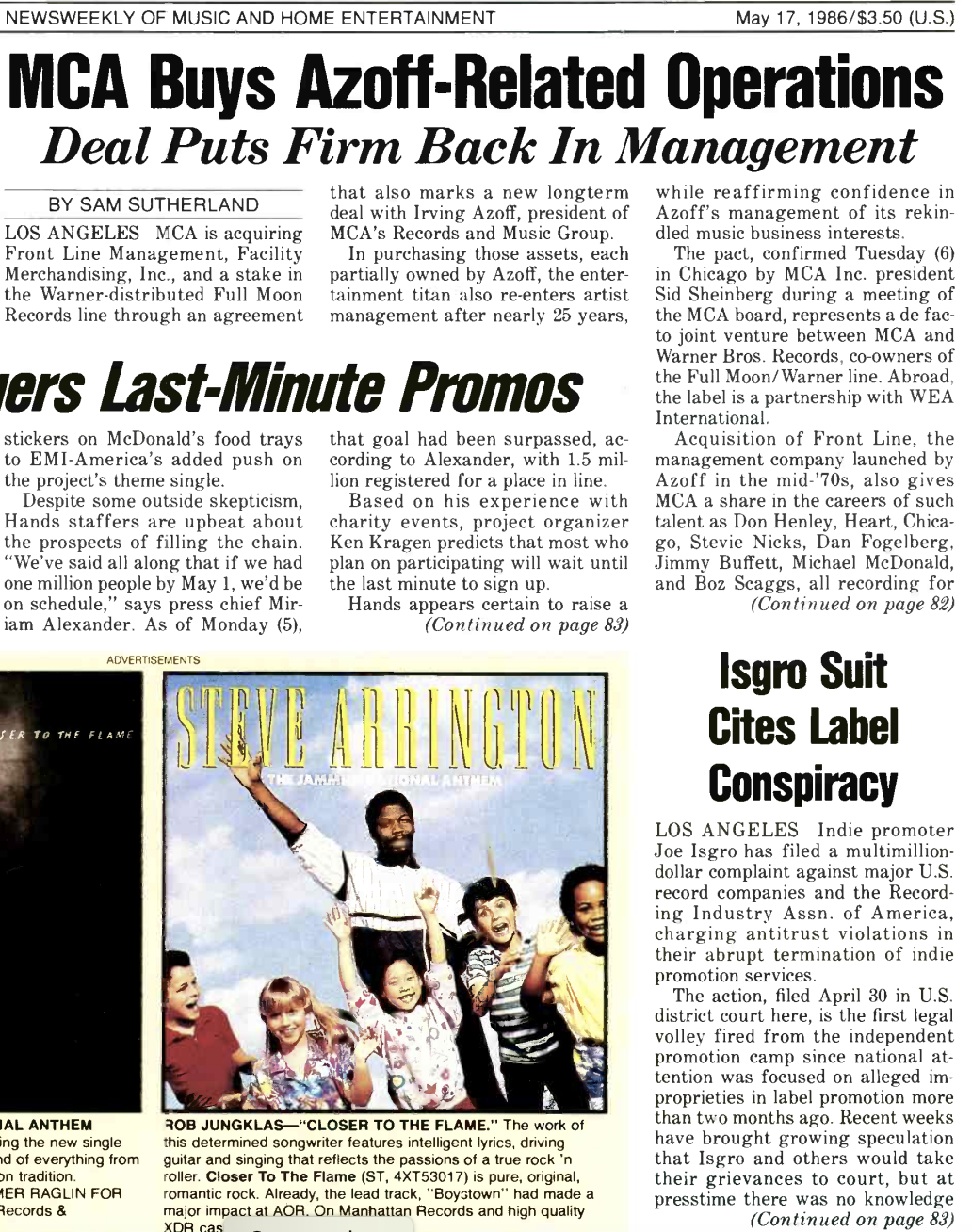
“A possible conflict of interest in MCA’s new management wing was reportedly screened through pre-purchase discussions with the antitrust wing of the Justice Department. An apparent green light thus reverses the 1962 consent decree that compelled MCA to abandon the talent agency business on which it was founded.” – Billboard, May 17, 1986
Rudnick Comes Under Investigation
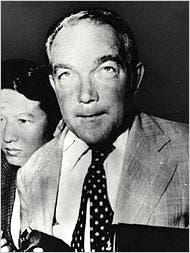
William Hundley had been RFK’s special assistant during the 1962 MCA antitrust case, as well as the former Chief of the Organized Crime Strike Force at the DOJ. Hundley left public service and became a criminal defense attorney. As the federal investigations heated up, Hundley had joined MCA’s legal team. In September 1987 Hundley went to D.C. to meet with DOJ officials and complained about Rudnick’s investigation into MCA executives.[16]
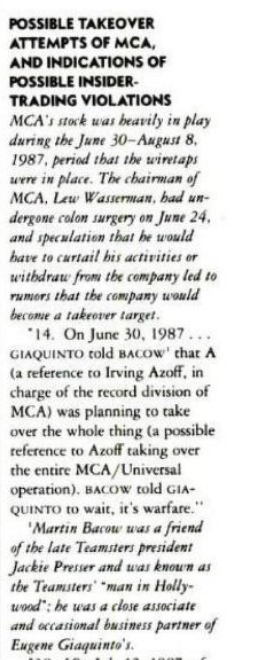
A few months later Rudnick was summoned to D.C. and met with David Margolis, the current Chief of the Organized Crime Strike Force at the DOJ. Margolis said that Rudnick was under investigation because of how he was conducting his investigation of MCA. Rudnick was told to restrict his case to Pisello, which he did not do and he was terminated.
Special Agent Thomas Gates, Eugene Giaquinto and Robert Booth Nichols
Special Agent Thomas Gates began investigating labor racketeering in the movie industry, but FBI wiretaps soon discovered that MCA’s Giaquinto was “mobbed up” with the Gambino crime family. Giaquinto had a cantankerous relationship with MCA Records President Azoff, who had old ties to the Genovese crime family. (One of the first bands that Azoff managed released a record with Levy’s Roulette Records in 1969.)
When Azoff and Giaquinto had a battle for control over MCA, it was allegedly the boss of the Gambino family, John Gotti, who brokered resolution of the conflict.[17]
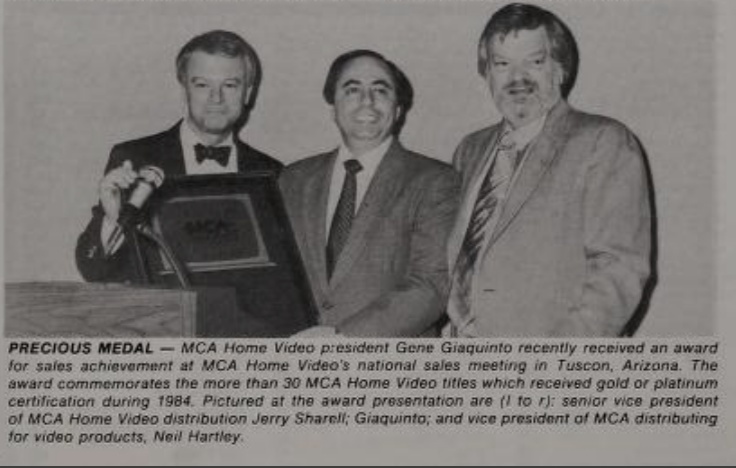
Eugene Giaquinto was President of the Home Entertainment Division of MCA and Robert Booth Nichols was his partner at Meridian International Logistics (MIL), which was believed to be a front company for international drug trafficking and money laundering. Through his connection to Giaquinto, Robert Booth Nichols even made efforts to be involved with the movie business. This included a small role in the movie Under Siege, as well as pitching screenplay ideas to MPAA President Jack Valenti based on his global exploits. Yet, according to government wiretaps, Nichols’ main gig was working with various intelligence agencies.
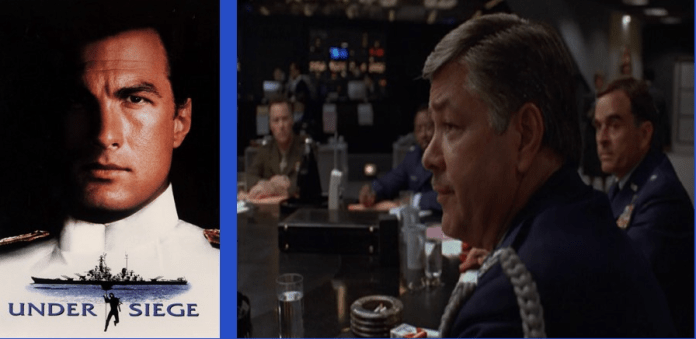
Robert Booth Nichols met with Special Agent Gates and learned the FBI investigation was regarding his relationship with MCA. Giaquinto resigned from MIL within days of learning about the investigation from Nichols. A conversation overheard on the FBI wiretaps had Giaquinto explicitly stating he would get Attorney General Meese to shut down the investigation related to MCA, which happened soon thereafter. While Giaquinto was forced out of MCA, it was due to funneling profits to the Mafia, MCA itself was insulated from scrutiny and the wiretaps were put under seal.

“We Might Have Stumbled Onto Another Iran-Contra”
Many believed that the federal investigations into MCA were shut down because it was directly connected to clandestine activities conducted by the broader Octopus enterprise. During the onslaught of investigations into MCA, Howard Baker even left the board of MCA to become President Reagan’s Chief of Staff. After much of the fracas died down, Baker would return to MCA.
The President of INSLAW, Bill Hamilton, believed that the investigation into MCA and John Booth Nichols was shut down was due to connection to the theft of the PROMIS software. It was believed that PROMIS was being utilized for numerous purposes, including spying on foreign intelligence agencies, money laundering of drug profits and funding unauthorized intelligence operations.[18]
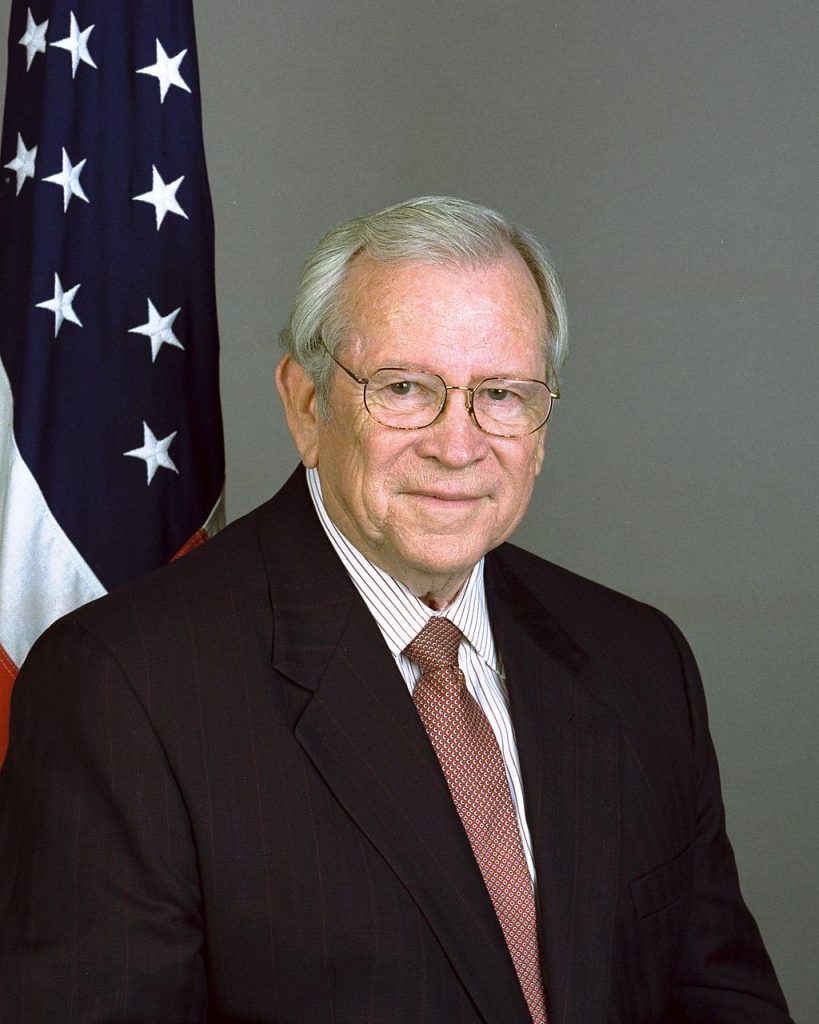

U.S. Attorney Richard Stavin spoke with Danny Casolaro who described to him how Nichols’ ties to MCA were a part of his broader Octopus investigation.[19] Stavin’s foray into the Octopus began with labor racketeering and payola. Yet, when he learned that MCA wanted to hire Nichols to fight piracy of MCA content, Stavin realized that the job could be a cover for a clandestine operation.
“It was our feeling that we might have stumbled onto another Iran-Contra,” said Stavin. “MCA could pay for Nichols to travel, visit certain countries, and act as a bagman to deliver money to foreign nations. We did not know that for a fact,” he stressed. “But that possibility became one of our working suppositions.”[20]
MCA Summary
A peculiar fact remains: The investigation into MCA was sealed and many of the files disappeared. Meanwhile, the feds have voluminous amounts of publicly available documents on its investigations into INSLAW/PROMIS, the Bank of Credit and Commerce International, the Iran-Contra Affair and more…Meese ultimately stepped down as Attorney General in 1988 in relation to an extensive investigation into the defense contractor Wedtech, which had received no-bid government contracts. Meese was cleared of wrongdoing in the Wedtech case, but there were issues discovered related to his personal finances. Yet, Litton Industries was another defense contractor that faced an investigation by Meese’s DOJ.
Litton Bionetics and Dr. Joseph Casolaro
Dr. Joseph D. Casolaro is mentioned in an autobiography of Litton’s founder Tex Thornton: The Litton Adventure That Was: A Tribute to the Founder Charles B. “Tex” Thornton (p. 434). Dr. Casolaro and Thornton worked with the military in the 1950s to run experiments on primates to see how well they tolerated the gravitational force of rocket-powered travel.
They wanted to determine if humans could ultimately withstand the physics required for space travel. A group of these researchers would later found Bionetics Research Laboratories, which included Dr. Joseph Casolaro. It is currently unclear to me the extent and duration of Dr. Casolaro’s involvement with Bionetics.
A Short History of Bionetics
Bionetics was founded in September 1961. “Bionetics’ first contract was for $169,000 from the National Institutes of Health (NIH) to study viruses and leukemia in simians.”[21] By 1962 Bionetics was among the first large-scale efforts in the country to induce cancer in primates.[22] The following year Bionetics was awarded government contracts one from the National Cancer Institute,[23] as well as another from the National Health Service to study the relationship between cancer and chemicals, including pesticides, insecticides and fungicides.[24]
It is unclear how closely Bionetics worked with the military, yet in the 1960s Bionetics did have contracts from the U.S. Army’s Biological Warfare Programs. A 1966 study conducted by Bionetics played a crucial role in the U.S. military’s decision to cease using Agent Orange in Vietnam due to its devastating health consequences, although the study’s results were not made public until a few years later.
Litton Industries Acquires Bionetics
Litton Industries was one of the United States’ biggest corporate conglomerates when it acquired Bionetics Research Labs in 1968. Bionetics and Litton were both heavily reliant on government contracts, yet Litton’s overt focus on military contracts may have changed how people viewed Bionetics’ biological and cancer research.
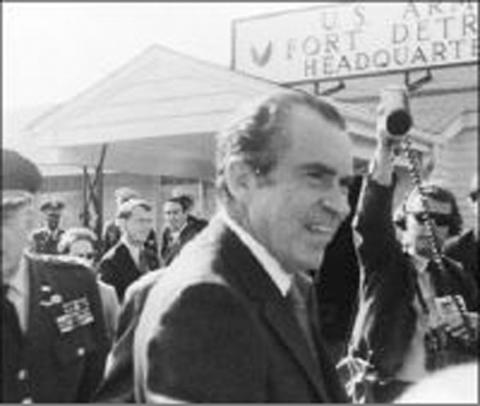
MK-NAOMI at Fort Detrick
In 1972 Litton Bionetics received a $6.85 million contract to operate the National Cancer Institute (NCI), a portion of which was relocated to Fort Detrick in Maryland. At the time this was the largest single award ever given by the National Institute of Health. Fort Detrick had previously housed Project MK-NAOMI, which ended in 1970.
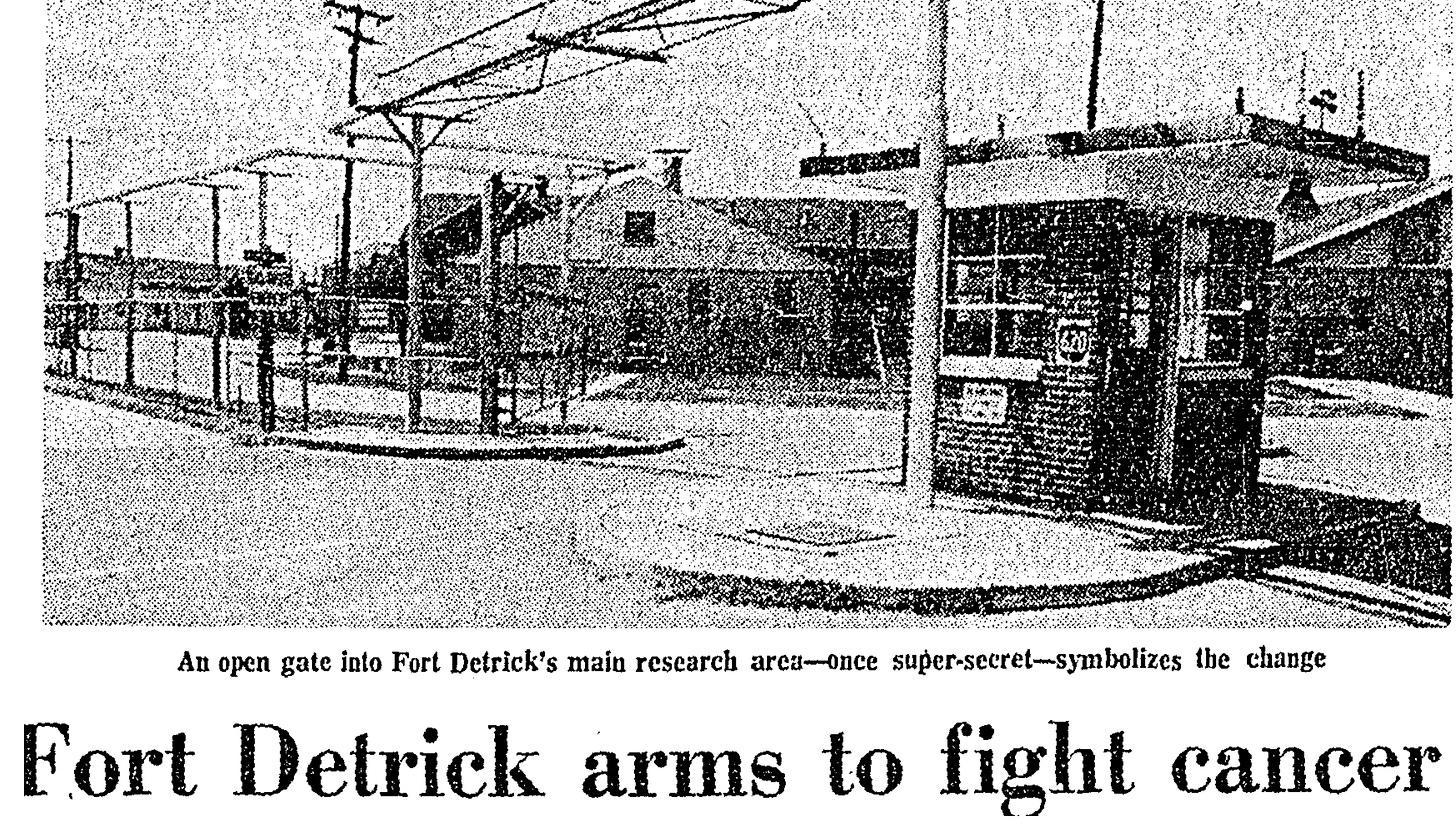
MK-NAOMI was a sub-project of the MK-ULTRA program, which the American people first learned about during the 1975 Church Committee hearings. MK-ULTRA is often believed to just be the CIA’s mind-control program, but it was an umbrella term for an array of more than 140 sub-projects.
In CIA documents MK-NAOMI was described as follows: “Under an agreement reached with the Army in 1952, the Special Operations Division (SOD) at Fort Detrick was to assist [the] CIA in developing, testing, and maintaining biological agents and delivery systems.”
In 1973 CIA Director Richard Helms ordered that all MK-ULTRA records be destroyed.
The Legacy of Litton Bionetics
“Litton Bionetics…was among the first companies licensed to develop, manufacture and sell diagnostic tests for the antibodies to the virus associated with acquired immune deficiency syndrome (AIDS).”[25] It was also a leader in cancer research, which included methods for inducing cancer in animals and potentially humans as well. Many people believe that the biowarfare activities at Fort Detrick did not end with MK-NAOMI in 1970. Plus, biowarfare was a particular concern in Danny Casolaro’s investigation.
Curiously, Biotech Capital Corporation housed a firm called American Bionetics, Inc., that also manufactured an AIDS antibody test. Earl Brian controlled Biotech Capital, which also housed Hadron, Inc. Recall that the Hamiltons believed that the PROMIS software was stolen by DOJ officials in order to give it to Hadron. When Edwin Meese was nominated to become Attorney General, his relationship with Earl Brian came under scrutiny because Meese was an investor in Biotech and Earl Brian had provided Meese’s wife with a $15,000 interest-free loan.
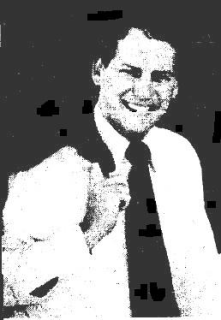
In summary, Dr. Joseph Casolaro founded a company called Bionetics and, over time, it would become a key player in studying cancer and developing AIDS antibody tests. Simultaneously, Edwin Meese and Earl Brian were a central part of Danny Casolaro’s investigation and they were involved in Biotech, which housed American Bionetics that manufactured AIDS antibody tests. These lines of research and development point back to the biowarfare activities at the Cabazon-Wackenhut Joint Venture.[26]
The Casolaro Conspiracy
Danny Casolaro was ambitiously searching for the truth. He wanted to expose deeply embedded corruption on a global scale. Many aspects of his research were ultimately proven to be correct.
Yet, given all the material this article covers, it is incredibly hard to believe that Danny only researched “the Octopus” for less than two years when “the Octopus’” tentacles weave through Danny’s whole life.
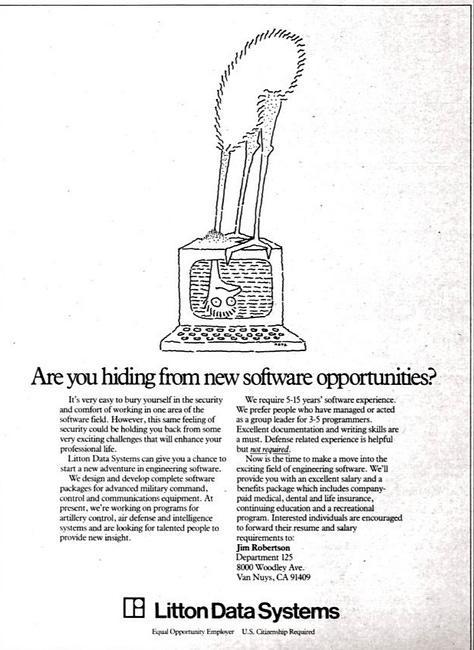
Who Was Dr. Joseph Casolaro?
There were other businesses that Dr. Joseph Casolaro was involved with besides being a physician, serving in the Army and founding Bionetics. There appears to be continuity in Dr. Casolaro’s professional involvement with businesses related to biomedicine and banks.
Dr. Casolaro served on the board of directors for the Community Savings and Loan Association in Rosslyn, which was then a member of the Federal Home Loan Bank Board, as well as Woodlawn National Bank of Alexandria. In a 1971 news article Dr. Joseph Casolaro is described as “an assistant professor at Georgetown University Medical School and President of Caltech Data Processing Co., a computer firm oriented towards bio-medicine.”
Coincidentally, Dr. Casolaro also opened two businesses in Martinsburg, West Virginia—the same town where Danny Casolaro would die. The businesses were named Valley Credit Corporation and International Bio-Medical Services, Inc. For unknown reasons—both businesses were dissolved by court order in June 1972.
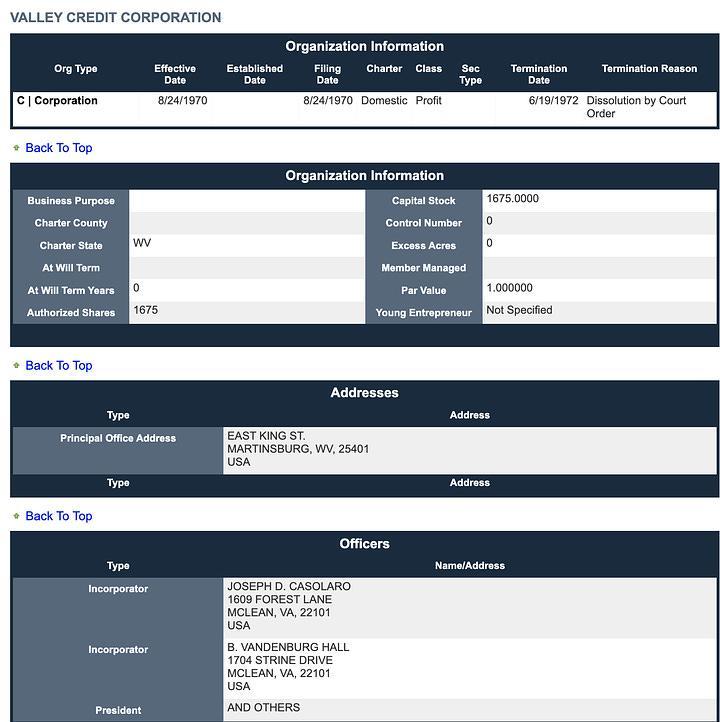
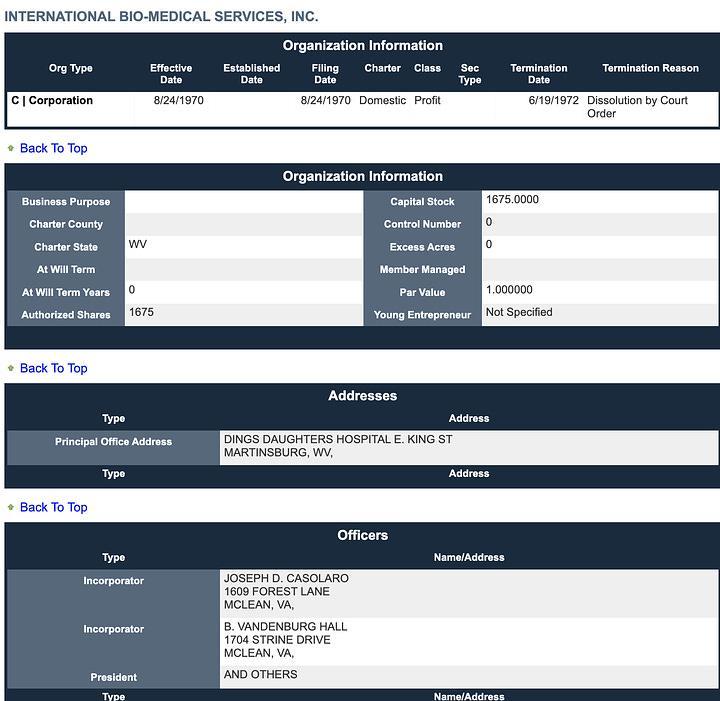
Epilogue: Danny Was a Target
Danny Casolaro’s entry point into the Octopus’s tentacles purportedly began with the government-sanctioned heist of the PROMIS software, which included the active participation of the Department of Justice in the cover-up.
Danny’s investigation involved many areas of his father’s work: Litton Industries, cancer research, biotechnology, bioweapons, and a savings and loan association. Dr. Joseph Casolaro would die of leukemia in 1982; ironically, the first contract Bionetics received was to study leukemia.
Is it any wonder that Danny was concerned he had been targeted by bioweapons? This is not an implausible conclusion considering the subjects of Danny’s investigation and that his autopsy revealed he had multiple sclerosis.
In 1991 a journalist asked Michael Riconosciuto about Danny’s concern that he was developing a brain disease:
“Oh, yes. He, uh, was concerned. And that was one of the reasons he had such an obsession [with this story]. Because he felt he had been hit by these people.”
“Hit by them?”
“He confided this to me to try to get me to talk further” about biological warfare projects he’d discovered, Riconosciuto explained.
– Vanity Fair, December 1991
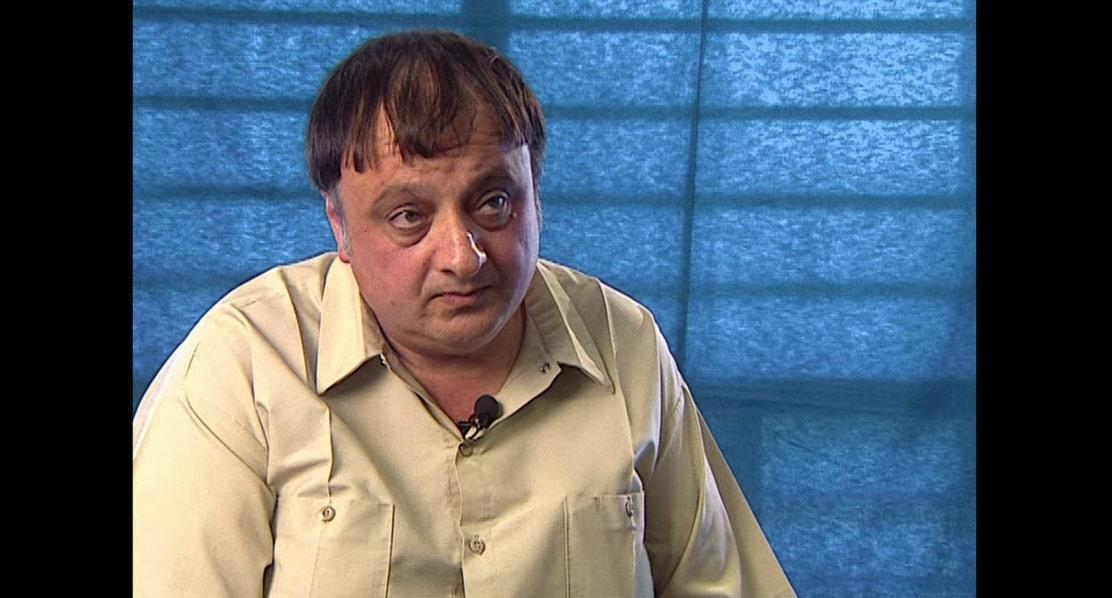
It is odd to me that Danny’s exploration of biological weapons has been downplayed in the current discourse around “the Octopus.” Furthermore, shortly before Danny died, he had expressed concern that he had been targeted by bioweapons.
Numerous people mentioned that Danny Casolaro had a source in Martinsburg because it is the location of the Internal Revenue Service’s National Computer Center. The massive computer was affectionately known as “The Martinsburg Monster.”
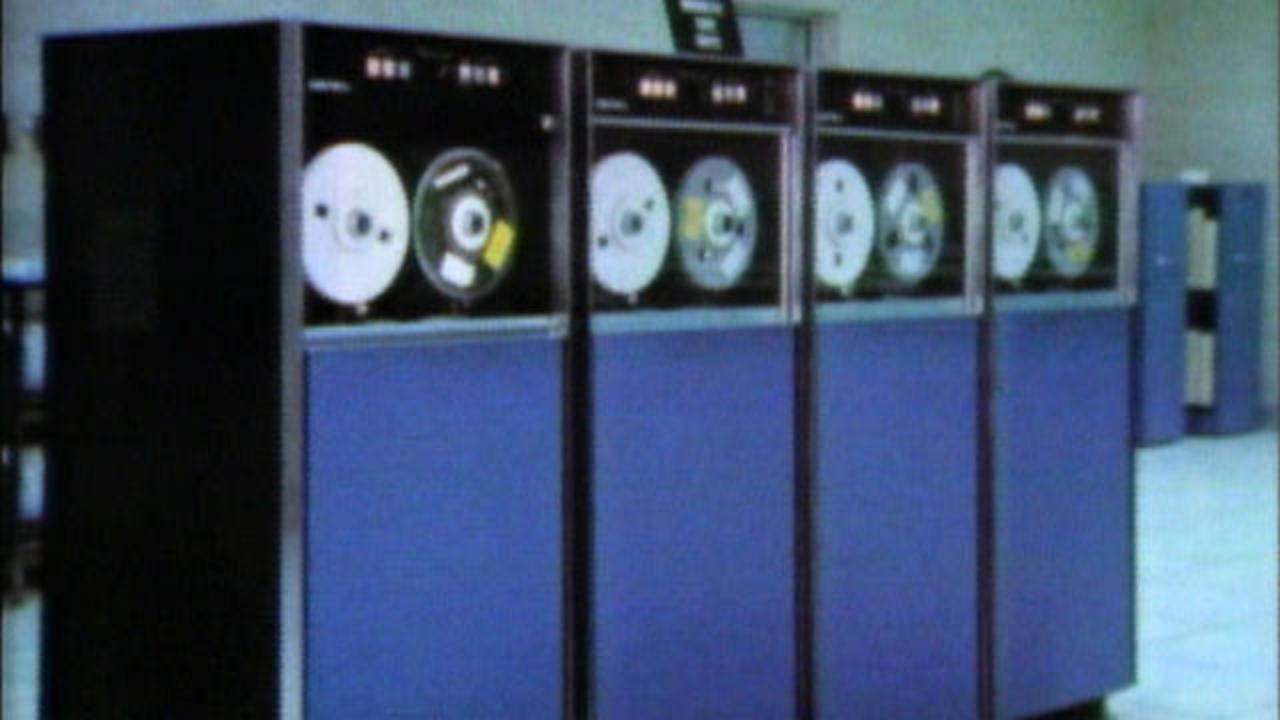
Perhaps the missing link of the public’s understanding of “the Octopus” is the possibility that MCA, Inc., was acting as a global front for the intelligence community and organized crime to participate in arms trading, bioweapons research and money laundering.
Maybe that is why Robert Booth Nichols told Danny: “If you continue this investigation, you will die.”

-
Gus Russo, Supermob: How Sidney Korshak and His Criminal Associates Became America’s Hidden Power Brokers (New York: Bloomsbury, 2006). ↑
-
Ronald Brownstein, The Power and the Glitter: The Hollywood-Washington Connection (New York: Pantheon, 1990). ↑
-
Brownstein, The Power and the Glitter. ↑
-
Phillip F. Nelson, LBJ: From Mastermind to “The Colossus” (New York: Skyhorse, 2014). ↑
-
Jack Valenti, This Time, This Place: My Life in War, the White House, and Hollywood (New York: Crown, 2007). ↑
-
Kathleen Sharp, Mr. & Mrs. Hollywood: Edie and Lew Wasserman and Their Entertainment Empire (New York: Carroll & Graf, 2003). ↑
-
Barney Oldfield, The Litton adventure that was: a tribute to the founder Charles B. “Tex” Thornton (Lincoln, NE: Kinman-Oldfield Family Foundation, 2006). ↑
-
Steven R. Weisman, “Editorial Observer; The Democratic Convention and the Ever-Changing Face of Los Angeles,” The New York Times, August 19, 2000. ↑
-
Bob Colacello, Ronnie & Nancy: Their Path to the White House – 1911 to 1980 (Boston: Warner Books, 2004). ↑
-
Beirne Lay, Jr., Someone Has to Make It Happen: the inside story of Tex Thornton, the man who built Litton Industries (Englewood Cliffs, NJ: Prentice-Hall, 1969). ↑
-
Ambrose I. Lane, Return of the Buffalo: The Story Behind America’s Indian Gaming Explosion (Westport, CT: Praeger, 1995). ↑
-
The BCCI Affair A Report to the Committee on Foreign Relations United States Senate by Senator John Kerry and Senator Hank Brown December 1992 102d Congress 2d Session Senate, https://info.publicintelligence.net/The-BCCI-Affair.pdf ↑
-
Cheri Seymour, The Last Circle: Danny Casolaro’s Investigation into The Octopus and the PROMIS Software Scandal (Walterville, OR: TrineDay, 2010), p. 349. ↑
-
Fredric Dannen, Hit Men: Power Brokers and Fast Money Inside the Music Business (New York: Vintage, 1990). ↑
-
William Knoedelseder, Stiffed: A True Story of MCA, the Music Business, and the Mafia (New York: HarperCollins, 1993). ↑
-
Dennis McDougal, The Last Mogul: Lew Wasserman, MCA, and the Hidden History of Hollywood (Boston: Da Capo Press, 1998). ↑
-
Seymour, The Last Circle. ↑
-
McDougal, The Last Mogul, pp. 487-88. ↑
-
Sharp, Mr. & Mrs. Hollywood, p. 449. ↑
-
Larry Weekley, “How to Succeed by Quitting,” The Washington Post, October 17, 1965. ↑
-
Tony Gleske, “44 Baby Monkeys Get Tender Care From Volunteer ‘Mothers’ Corps,” The Washington Post. May 5, 1962. p. A1. ↑
-
Victor Cohn, “Many Chemicals Give Mice Cancer.” The Washington Post. April 17, 1969. ↑
-
“Contract to Study Cancer Effects Of Pesticides Given to Virginia Firm,” The Washington Post. December 29, 1963. ↑
-
Nell Henderson, “Litton Sells Part of Biotech Unit,” The Washington Post. August 26, 1985. ↑
-
Seymour, The Last Circle. ↑
CovertAction Magazine is made possible by subscriptions, orders and donations from readers like you.
Blow the Whistle on U.S. Imperialism
Click the whistle and donate
When you donate to CovertAction Magazine, you are supporting investigative journalism. Your contributions go directly to supporting the development, production, editing, and dissemination of the Magazine.
CovertAction Magazine does not receive corporate or government sponsorship. Yet, we hold a steadfast commitment to providing compensation for writers, editorial and technical support. Your support helps facilitate this compensation as well as increase the caliber of this work.
Please make a donation by clicking on the donate logo above and enter the amount and your credit or debit card information.
CovertAction Institute, Inc. (CAI) is a 501(c)(3) non-profit organization and your gift is tax-deductible for federal income purposes. CAI’s tax-exempt ID number is 87-2461683.
We sincerely thank you for your support.
Disclaimer: The contents of this article are the sole responsibility of the author(s). CovertAction Institute, Inc. (CAI), including its Board of Directors (BD), Editorial Board (EB), Advisory Board (AB), staff, volunteers and its projects (including CovertAction Magazine) are not responsible for any inaccurate or incorrect statement in this article. This article also does not necessarily represent the views the BD, the EB, the AB, staff, volunteers, or any members of its projects.
Differing viewpoints: CAM publishes articles with differing viewpoints in an effort to nurture vibrant debate and thoughtful critical analysis. Feel free to comment on the articles in the comment section and/or send your letters to the Editors, which we will publish in the Letters column.
Copyrighted Material: This web site may contain copyrighted material the use of which has not always been specifically authorized by the copyright owner. As a not-for-profit charitable organization incorporated in the State of New York, we are making such material available in an effort to advance the understanding of humanity’s problems and hopefully to help find solutions for those problems. We believe this constitutes a ‘fair use’ of any such copyrighted material as provided for in section 107 of the US Copyright Law. You can read more about ‘fair use’ and US Copyright Law at the Legal Information Institute of Cornell Law School.
Republishing: CovertAction Magazine (CAM) grants permission to cross-post CAM articles on not-for-profit community internet sites as long as the source is acknowledged together with a hyperlink to the original CovertAction Magazine article. Also, kindly let us know at info@CovertActionMagazine.com. For publication of CAM articles in print or other forms including commercial internet sites, contact: info@CovertActionMagazine.com.
By using this site, you agree to these terms above.
About the Author
Melanie L. Carlson is an indie researcher who works at the nexus of the hegemonic pop culture industry, corporate consolidation and upperworld crime.
She stopped being a nihilistic punk in 2002 after getting an underaage drinking charge and choosing to do community service at Athens Free Press.
She spent 10 years working in the domestic violence field as a survivor advocate, scholar, and educator. You can read her contemporary investigative work on Substack and her older works on her website. Mx_Defying is her handle across social media platforms.
Melanie can be reached at: melaniecar@gmail.com.

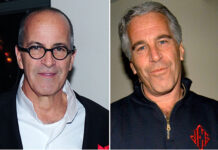
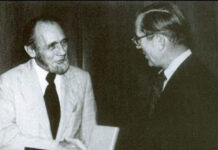
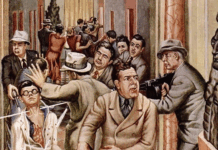

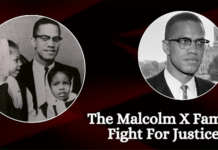
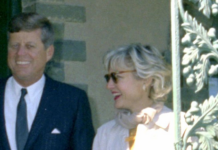
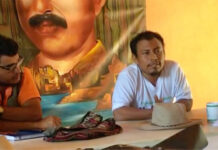

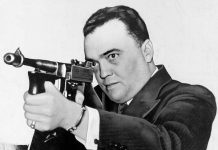

>satiated the following statement: [NOTE: “satiated”? I don’t understand.]
Substantiated?
Vladimir Putin: Google “Polygraph test of Ella Gareeva”